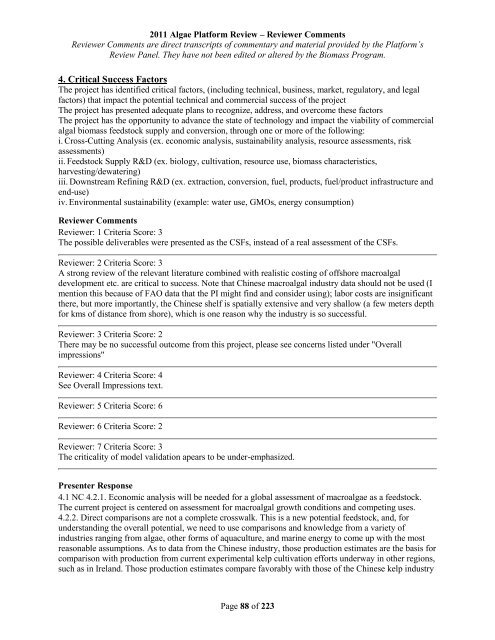Reviewer Comments - EERE
Reviewer Comments - EERE
Reviewer Comments - EERE
You also want an ePaper? Increase the reach of your titles
YUMPU automatically turns print PDFs into web optimized ePapers that Google loves.
2011 Algae Platform Review – <strong>Reviewer</strong> <strong>Comments</strong><br />
<strong>Reviewer</strong> <strong>Comments</strong> are direct transcripts of commentary and material provided by the Platform’s<br />
Review Panel. They have not been edited or altered by the Biomass Program.<br />
4. Critical Success Factors<br />
The project has identified critical factors, (including technical, business, market, regulatory, and legal<br />
factors) that impact the potential technical and commercial success of the project<br />
The project has presented adequate plans to recognize, address, and overcome these factors<br />
The project has the opportunity to advance the state of technology and impact the viability of commercial<br />
algal biomass feedstock supply and conversion, through one or more of the following:<br />
i. Cross-Cutting Analysis (ex. economic analysis, sustainability analysis, resource assessments, risk<br />
assessments)<br />
ii. Feedstock Supply R&D (ex. biology, cultivation, resource use, biomass characteristics,<br />
harvesting/dewatering)<br />
iii. Downstream Refining R&D (ex. extraction, conversion, fuel, products, fuel/product infrastructure and<br />
end-use)<br />
iv. Environmental sustainability (example: water use, GMOs, energy consumption)<br />
<strong>Reviewer</strong> <strong>Comments</strong><br />
<strong>Reviewer</strong>: 1 Criteria Score: 3<br />
The possible deliverables were presented as the CSFs, instead of a real assessment of the CSFs.<br />
<strong>Reviewer</strong>: 2 Criteria Score: 3<br />
A strong review of the relevant literature combined with realistic costing of offshore macroalgal<br />
development etc. are critical to success. Note that Chinese macroalgal industry data should not be used (I<br />
mention this because of FAO data that the PI might find and consider using); labor costs are insignificant<br />
there, but more importantly, the Chinese shelf is spatially extensive and very shallow (a few meters depth<br />
for kms of distance from shore), which is one reason why the industry is so successful.<br />
<strong>Reviewer</strong>: 3 Criteria Score: 2<br />
There may be no successful outcome from this project, please see concerns listed under "Overall<br />
impressions"<br />
<strong>Reviewer</strong>: 4 Criteria Score: 4<br />
See Overall Impressions text.<br />
<strong>Reviewer</strong>: 5 Criteria Score: 6<br />
<strong>Reviewer</strong>: 6 Criteria Score: 2<br />
<strong>Reviewer</strong>: 7 Criteria Score: 3<br />
The criticality of model validation apears to be under-emphasized.<br />
Presenter Response<br />
4.1 NC 4.2.1. Economic analysis will be needed for a global assessment of macroalgae as a feedstock.<br />
The current project is centered on assessment for macroalgal growth conditions and competing uses.<br />
4.2.2. Direct comparisons are not a complete crosswalk. This is a new potential feedstock, and, for<br />
understanding the overall potential, we need to use comparisons and knowledge from a variety of<br />
industries ranging from algae, other forms of aquaculture, and marine energy to come up with the most<br />
reasonable assumptions. As to data from the Chinese industry, those production estimates are the basis for<br />
comparison with production from current experimental kelp cultivation efforts underway in other regions,<br />
such as in Ireland. Those production estimates compare favorably with those of the Chinese kelp industry<br />
Page 88 of 223




